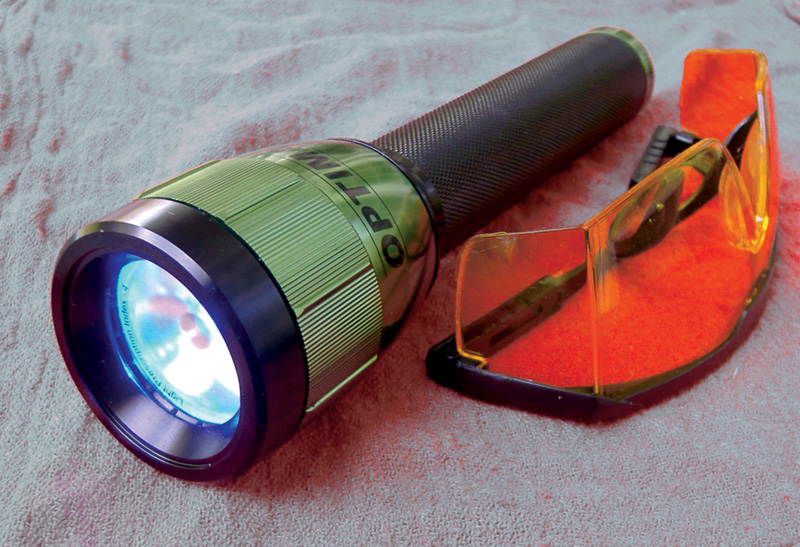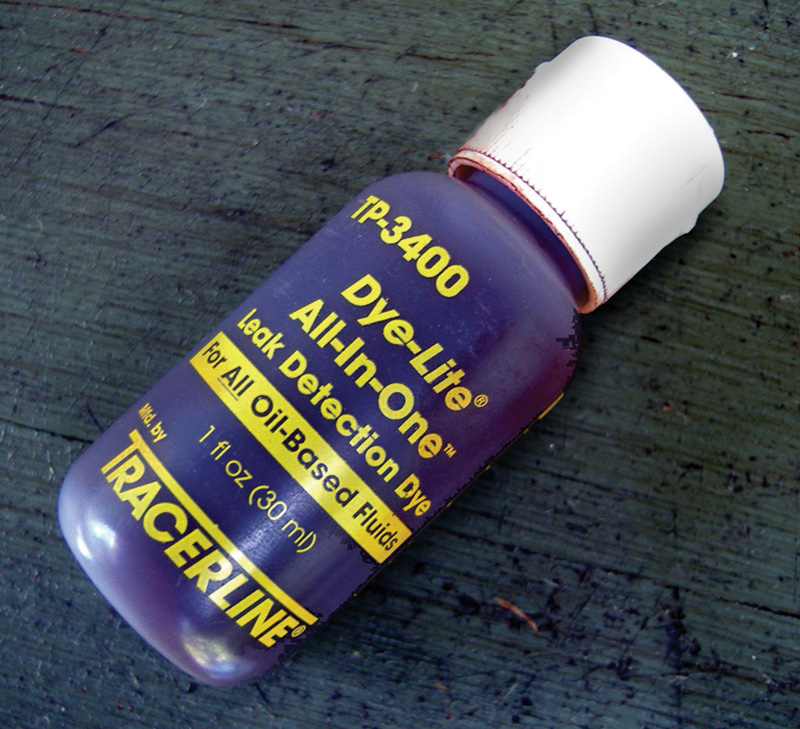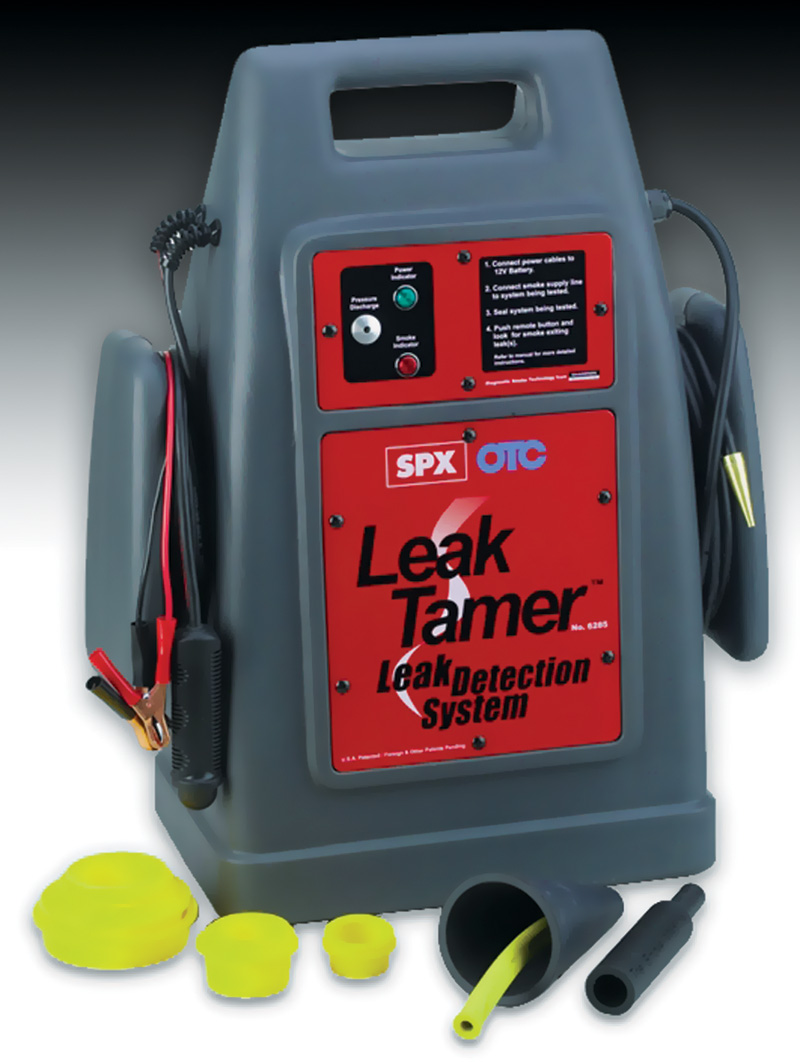Dyes, electrons, and smoke will upgrade your leak detection skills
Mercedes-Benz designs and manufactures some of the tightest, most leak resistant vehicles on the road. But even a Mercedes can develop a leak.
No matter where, no matter what, a leak means a seal or connection has failed. Back in the day, “leak†meant engine oil, trans fluid, brake fluid, or coolant was not where it was supposed to be. Today, “leak†means not only something getting out, but also something getting in—specifically air entering any one of the vacuum lines, disrupting the precise control of the OBD II system.
Modern automotive technology and design have complicated leak detection. You know better than anyone else how congested the underhood area is. Just being able to see below the top layer of components can be a challenge. All that plumbing and all those parts create a convoluted pathway that allows leaking fluids to travel a long way from their source before hitting the ground.
The old days of placing clean shop rags or newspaper under a car to locate the source of a leak are gone. The oil drip that leaves a spot near the rear of the engine might be a bad rear main seal. Or, it can be from a leak high up, near the front of the engine that meandered to the back before finally dripping off. When working on leaks, don’t waste time identifying where the fluid eventually drips to the ground. Focus on where the leak originates!
Explain the charges
When your customer pulls into your shop with a complaint of a spot on his or her garage floor, or a check of various dipsticks and reservoirs indicates a low fluid condition, your job is to fix the leak. But you can’t fix the leak until you find the leak. Unless you are dealing with a gusher that is painfully obvious to see, finding leaks on a Mercedes-Benz vehicle will probably require help in the form of using one of the leak detection technologies now available for automotive repair.
When you write up a work order for leak repair, make sure you take time to explain to your customer that unless the source of the leak is obvious, you must do leak testing to pinpoint the source of the problem. Stress that the charge for leak detection is independent of any costs for actually repairing the leak. In fact, if your customer decides not to approve the leak repair, he or she will still be billed for leak detection.
Fixing a leak is like repairing an engine performance problem. You don’t quote a cost to solve an “engine runs rough†complaint until you’ve done some basic diagnostics. And you shouldn’t give a quote for leak repair until you have identified the cause of the leak.
The different leak detection systems all have one thing in common—they work much better on a clean vehicle. Although the typical Mercedes-Benz owner probably keeps his or her car cleaner than the average vehicle owner, you know that you still encounter a Mercedes with a dirty, if not filthy, underhood area. It is a good practice to include the cost of cleaning the underhood area as part of your quote for leak detection. The work should be done if the car is dirty. If the car is clean, you can earn some good customer relationship points by explaining that you are deducting the cost of cleaning “because you take such good care of your car.â€

A powerful, modern ultraviolet or “black” light is one of the most dependable methods of tracking down a leak regardless of what fluid is involved.
Go To Black
Despite the problems with limited visibility and access, the first step in leak detection, after cleaning the area, is still a good visual inspection using a bright light. You might get lucky and spot the leak. But, often, you will need help finding the leak. After decades on the market, the go to solution for finding most fluid leaks is still ultraviolet or black light technically called “fluorescent leak detection.â€
Dye leak detection is easy. After you have identified the type of fluid that is leaking, you just add dye to the system. (For a coolant leak, don’t add the dye until the engine is cool.) Start the engine, let it run for a while or take the car on a test drive. Then scan with the black light. Use a small, flexible shop mirror to reflect the black light into areas you can’t hit directly with the light.
Under the black light, the fluorescent dye turns a bright color that virtually screams, “Here’s the leak! Here’s the leak!†The specific color you will see varies depending on the dye manufacturer and the system being checked.
Large leaks show up quickly, minor leaks will take longer for the dye to appear. A test drive of 15 to 20 minutes should reveal any leak that is worth worrying about. A coolant system leak typically won’t appear until the engine is completely warmed up.
If your shop is still using an early, low-powered black light, you are years overdue for an upgrade. The original 25 watt lights required darkened conditions to spot the dye. Today’s 50-watt, 100-watt, and higher black light bulbs have no such limitations. You can use them in a well lighted area. The higher wattage bulbs make it easy to spot even the smallest dye trace coming from a leak.
In fact, high output black lights should not be used unless you are wearing the yellow-tinted safety glasses that are included with the more powerful lights. These glasses not only protect your eyes, but also make the dye color “pop†even stronger.
A side benefit of fluorescent dyes is their ability to sell a customer on the need for having the repair done. Walk your customer over to their Mercedes-Benz, explain how the dye works, give them a pair of safety glasses, turn on the black light, and let them see the leak themselves. When your customer returns to pick up their car, offer to show them that the leak is fixed by giving them another black light demonstration. They will love the show!

This universal dye works in engine oil, ATF, power steering fluid and coolant. It doesn’t take much to do the job.
Fluorescent leak detection is safe and won’t harm any components, as long as you follow the dye manufacturer’s recommendations regarding the quantity to add. When testing for cooling system leaks on any late model Mercedes-Benz, make sure that the dye is approved for use with “long life†coolants.
Dye manufacturers differ on their approach to using dyes for different systems. For example, Tracerline® offers a wide array of dyes, recommending a different type for each system. Snap-On® offers a single dye that can be used for testing engine oil, transmission fluid, power steering fluid, hydraulic oils, gasoline, and diesel fuel leaks. When equally reputable companies recommend total opposite approaches, we can only say it is your call which system to choose. However, for A/C work, Tracerline® is the only dye approved by Mercedes-Benz for use on its vehicles.
Snap-on® offers two neat tips that will give you better results when using a black light and dye to locate leaks:
- A/C evaporator leaks can be hard to find. If you suspect an evaporator leak, inject A/C dye into the system. Start the engine and let it idle with the A/C fan at its highest speed setting and the temperature at its coldest setting. Place a piece of white paper under the evaporator case drain hose. Once water starts dripping from the hose, shine your black light at the paper. If the evaporator is leaking, you will see traces of dye on the paper!
- Dirty engine oil leaking from a dirty engine can be hard to find. In addition to cleaning the engine, change the oil, and then add the dye. If you still have trouble finding the oil leak, add one 4-oz. bottle of A/C dye to the crankcase. The A/C dye will boost the fluorescing properties of the engine oil dye, making the leak site stand out even more.

This screw and cartridge set-up is one way to force fluorescent dye into an A/C system against the pressure of the refrigerant. The cartridge idea makes billing the customer more straightforward.
A/C Leak Detection
Major A/C leaks are usually easy to find because they are caused by a large hole or major component failure. Slow leaks are a different story. Especially since the use of R134a was mandated in the 1990s, detecting slow A/C leaks can be very frustrating.
Early electronic “sniffers†were useful, but they had a serious problem—they were too sensitive and often indicated a “leak†when the sniffer was reacting to some transient gas, not refrigerant, in the area.
Two different technologies are used in the current generation of A/C leak detectors—one is called Negative Corona (also known as Corona or Electron Discharge) and the other is Heated Sensor (also referred to as Heated Diode, Hot Anode, Heated Triode and Heated Pentode™).
Both types are very sensitive, capable of detecting leaks as small as 1/4 ounce (7 grams) of refrigerant per year! The big difference is their “selectivity.†Negative Corona detectors are still prone to reacting to substance other than refrigerant. A Corona detector can react to water vapor, ethylene, and propylene glycol (antifreezes), brake cleaners and other solvents, in addition to refrigerant.
Heated sensors are less likely to react to anything other than refrigerant. Because heated sensors don’t give off as many “false alarms,†these units are far more popular for automotive service work.
The decision to use electronic detection versus dyes is based primarily on time. Electronic detection can be done as soon as there is refrigerant in system and the A/C is turned on. You don’t waste time adding a dye and waiting for the dye to appear at the leak site. With their extreme sensitivity, electronic detectors can find a small leak in a few minutes while a dye might not show up for an hour if the leak is a pinpoint. Electronic detectors are also more convenient because they reach into areas that are hard to see with a black light.
The electronic detectors are not without their disadvantages. Refrigerant technology is changing, about the only thing that you can say for certain is that R134a probably won’t be around for too many more years. A new refrigerant may require new electronic leak detectors because today’s units simply won’t be able to detect a new refrigerant.
Unlike dyes, electronic sensors are influenced by environmental conditions. Dirt, moisture, high humidity, and air movement from wind, fans, or the shop ventilation system can interfere with their effectiveness. The units also work better when air temperatures are high because warmer conditions tend to increase leak rates.
Because A/C leaks can be so frustrating to find, many shops have both dye and electronic detectors and technicians use both systems. Occasionally, a technician will use both systems at the same time to track down a real problem leak.

Smoke generators have come a long way in the decade or so they’ve been around. They’re fairly expensive, but sometimes nothing else will do the job (courtesy OTC).
Making Smoke
Smoke leak detection has been used for many years in other industries, but it first appeared in automotive service about 10 years ago, becoming popular a few years ago. The term “smoke†is actually misleading. Smoke is produced when something burns. Units for automotive use don’t create smoke, but rather a “visible gas†or “fog.†But “visible gas generator†or “fog generator†doesn’t have the marketing impact of “smoke generator†so “smoke is the term that is used.
Although smoke units have been around for a long time, the somewhat slow acceptance of smoke leak detection was due to several reasons:
- Shop owners’ reluctance to invest in new technology.
- Overselling the systems. Smoke leak detection units are not “one size fits all, no other leak detection needed†solutions.
- Lack of standardization and the specific needs of automotive service.
These issues have generally been resolved. The technology is no longer new to the service industry; smoke machines play an important role in leak detection, but they don’t eliminate the need for other technologies; and the EVAP-approved units are designed for automotive applications.
Smoke is simple to use. With the engine off, connect the unit to the system being tested using one of the various adaptors provided by the equipment manufacturers. Turn the unit on and wait for the smoke to come out, indicating the leak site. If there is no leak, instead of seeing smoke come out from the system being tested, the backpressure will push the smoke out of the unit.
For locating vacuum leaks smoke is unbeatable. An EVAP-approved unit uses a low pressure smoke generator that produces a non-toxic, inert “smoke.†Because the smoke is inert (does not react with other substances) it will not damage any sensitive emission control components. The smoke also does not leave a residue that could interfere with OBD II.
Smoke is also very useful in finding A/C leaks, especially those in hard to reach places where it can be difficult to see dye or probe with an electronic detector. Some units combine the benefits of smoke with fluorescent dyes. The smoke carries a dye that shows up under a black light.
The downside to smoke leak detection is cost. The units are much more expensive than other leak detection systems. In addition to the cost for the basic machine, you will also have to purchase a variety of adaptors to connect the unit to different systems on the car.

Some smoke machines allow you to adjust the pressure, but they never produce enough p.s.i. to damage any components or seams (courtesy OTC).
The advantage to smoke machines, in addition to being the most effective way to find a vacuum leak, is their flexibility to find almost any type of leak. Whether smoke detection can be done as fast and as cheaply per test compared to dye depends on the test, but smoke is versatile. With a smoke unit, you can test for:
- Any vacuum leaks, not just EVAP system. If you can find a place to connect the smoke machine, you can test any vacuum line or vacuum controlled component.
- Exhaust system leaks from the exhaust manifold to the tailpipe.
- Oil leaks from any part of the engine.
- Air leaks around doors and glass.
If you are considering a smoke unit, make sure it is EVAP-approved. The units from the major manufacturers and tool distributors are, but a cheapo unit from Joe’s Bargain Tools might not be. If the unit isn’t EVAP-approved, you can damage emission control systems by introducing a gas that either reacts with system components or leaves a residue throughout the system.
These units generate smoke at low pressure, typically less than 10 psi, to prevent damaging components. Some units, however, run at very low pressures, down around 1 to 2 psi and that may not be enough to push the smoke through the system and find the leak. Some units allow you to regulate the output pressure.
As a Mercedes-Benz specialist, your customers expect premium service for their cars. Choosing the appropriate leak detection equipment for the work you do in your shop will enable you to meet your customer’s expectations.






0 Comments